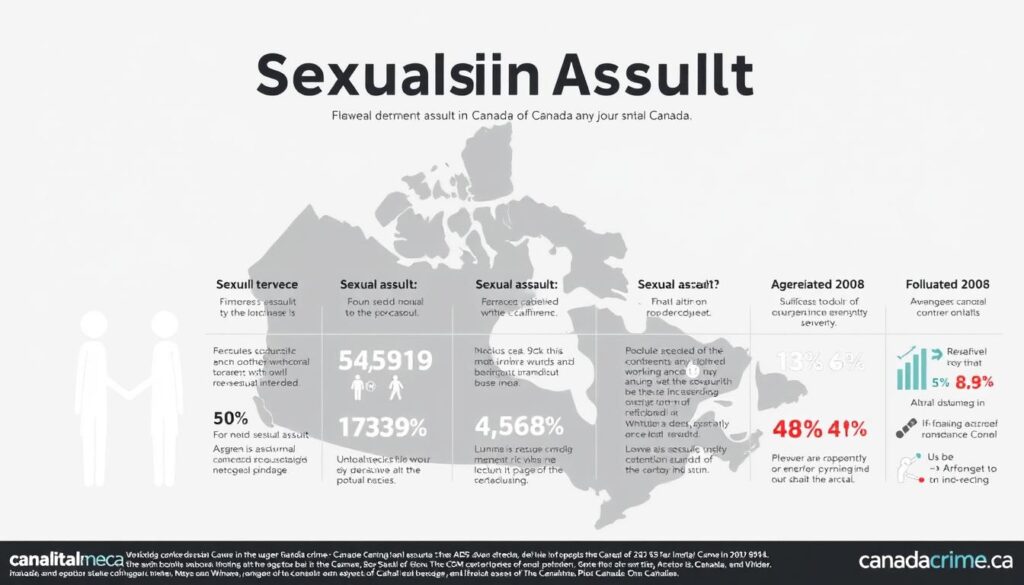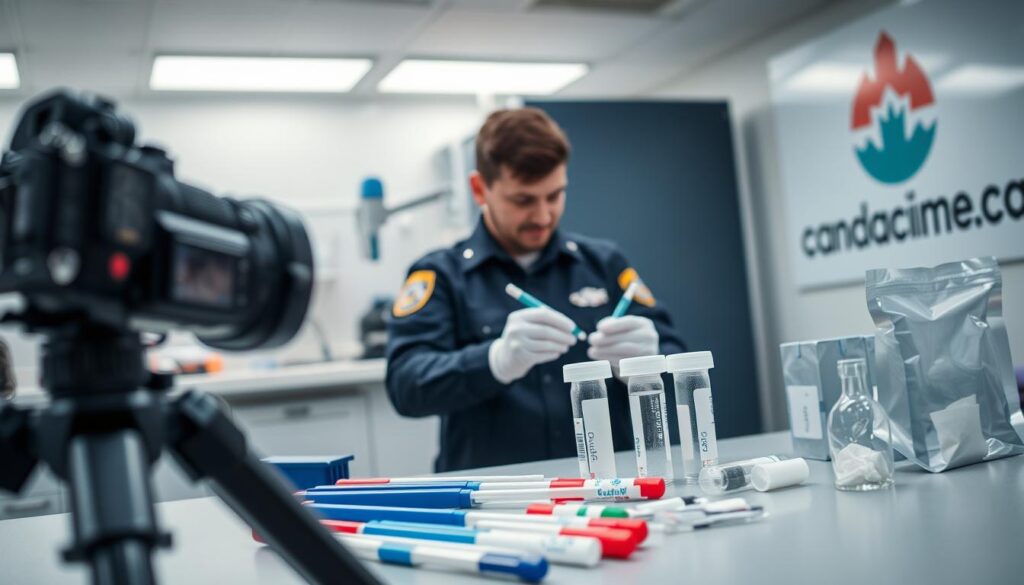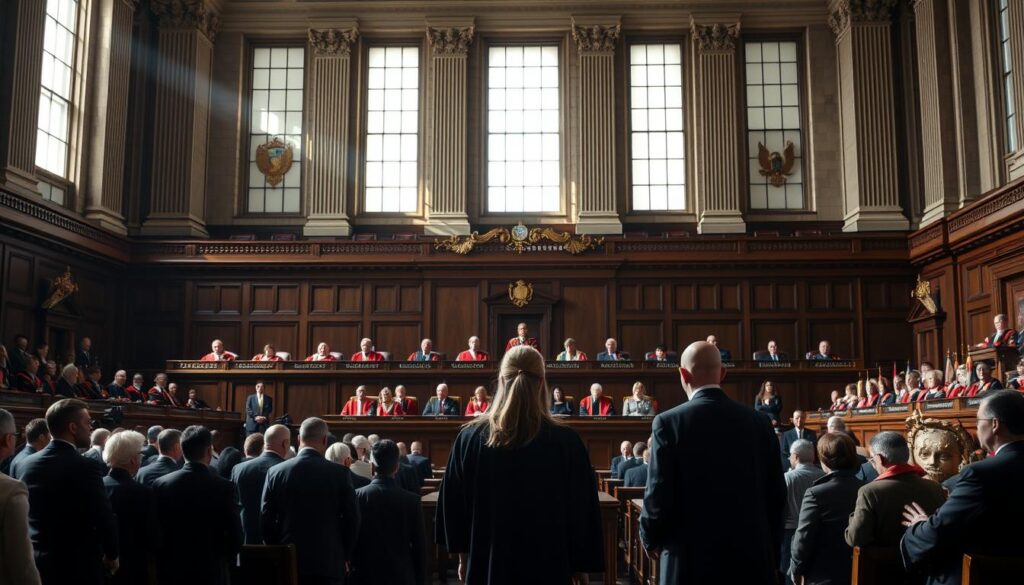Each year, about 4,500 Canadians report severe sexual violence. Experts believe this is only 5% of actual cases. These numbers hide stories of life-changing trauma for victims and communities.
Canadian law calls it aggravated sexual assault when sexual violence involves wounding or life-endangering acts. This sets it apart from other sexual violence due to its extreme harm.
Understanding these legal details is crucial for everyone. It helps victims seek justice and guides legal pros in handling cases. It also raises public awareness about these serious crimes.
This article explains the laws for these offenses. It shows how cases move through courts. You’ll also learn about support for survivors.
This info is vital for legal experts, concerned citizens, and those helping survivors. It provides key context for dealing with these tough situations.
What Constitutes Aggravated Sexual Assault in Canada
Canadian law distinguishes aggravated sexual assault from other sexual violence. It’s the most serious sexual offense in Canada’s criminal justice system. Prosecutors must prove additional harmful elements beyond the sexual assault itself.
Legal Definition Under the Criminal Code
Section 273(1) of the Canadian Criminal Code defines aggravated sexual assault. It occurs when someone wounds, maims, disfigures, or endangers life during a sexual assault. This language sets it apart from other sexual crimes.
Key Elements of the Offense
Prosecutors must prove two fundamental components for aggravated sexual assault:
- That a sexual assault occurred
- That the assault included at least one aggravating factor (wounding, maiming, disfiguring, or endangering life)
Both elements must exist simultaneously during the same incident. This differs from other criminal offenses.
Intent Requirements
The mental element (mens rea) is crucial in aggravated sexual assault cases. Prosecutors must prove beyond doubt that you:
- Intentionally applied force without consent
- Knew or were reckless about whether the complainant consented
- Either intended to cause serious harm or were reckless about the possibility
Circumstances That Elevate Sexual Assault to “Aggravated”
Not all sexual assaults are “aggravated” under Canadian law. Specific circumstances must increase the offense’s severity substantially.
Severe Physical Harm
Courts consider physical harm “severe” when it meets certain criteria. These include lasting injury, significant medical intervention, and substantial bodily function impairment.
Weapons Involvement
Weapons dramatically escalate a sexual assault case. This includes using firearms, threatening with weapons, or using objects as weapons.
Even displaying a weapon can qualify the offense as aggravated. This applies if it endangers the victim’s life, even without direct use.
The Canadian Criminal Code and Sexual Offenses
Canada’s Criminal Code sets clear boundaries for non-consensual sexual acts. It has evolved to reflect changing attitudes toward sexual violence. This framework is crucial for understanding sexual offense cases in Canadian law.
Section 273 and Related Provisions
Section 273 addresses aggravated sexual assault in the Criminal Code. It defines it as sexual assault that harms or endangers the victim’s life. This is the most serious form of sexual abuse in Canadian law.
The Code has a three-tiered approach to sexual assault. Section 271 covers basic sexual assault. Section 272 deals with assault involving weapons or threats.
Consent provisions are vital in sexual offense laws. Section 273.1 defines consent as voluntary agreement to sexual activity. Section 273.2 limits the defense of mistaken belief in consent.

Historical Development of Sexual Assault Laws in Canada
Canadian sexual assault laws have changed with society. Before 1983, laws used “rape” and “indecent assault” instead of “sexual assault”. These changes show growing awareness of sexual abuse’s serious nature.
Key Legislative Reforms
In 1983, the Criminal Code replaced “rape” with three levels of “sexual assault”. This shifted focus from sexual nature to violent, non-consensual aspects of the crime.
Bill C-49 in 1992 defined consent and limited the “mistaken belief” defense. It responded to the R. v. Seaboyer decision and strengthened protections for survivors.
Bill C-51 in 2018 clarified consent and expanded rape shield protections. These changes address legal gaps and better protect sexual abuse victims.
| Time Period | Legal Terminology | Focus of Law | Consent Standard |
|---|---|---|---|
| Pre-1983 | Rape/Indecent Assault | Sexual virtue/morality | Physical resistance required |
| 1983-1992 | Sexual Assault (3 levels) | Violence and harm | Implicit consent allowed |
| 1992-2018 | Sexual Assault (refined) | Violation of autonomy | Affirmative consent model |
| 2018-Present | Sexual Assault (expanded) | Consent and capacity | Explicit ongoing consent |
Shifts in Legal Interpretation
Canadian courts’ interpretation of sexual assault laws has changed over time. Early cases focused on victim behavior. Modern jurisprudence emphasizes consent and autonomy in a victim-centered approach.
The law of sexual assault has evolved to recognize that this crime is not about sex but rather about acts of violence that use sex as a weapon to assert power and control.
R. v. Ewanchuk (1999) ruled out “implied consent” in Canadian law. R. v. J.A. (2011) clarified that unconscious people can’t consent to sexual activity. These decisions strengthened protections against non-consensual acts and clarified consent standards.
Distinguishing Between Levels of Sexual Assault
Canada’s Criminal Code defines three levels of sexual assault based on severity and harm. This system helps legal professionals understand the varying degrees of these crimes. Each level has different felony charges and requires specific investigation approaches.
Level 1: Simple Sexual Assault
Level 1 sexual assault involves unwanted sexual touching without consent where no physical injury occurs. It represents 87% of all reported sexual assault cases in Canada. Level 1 offenses can result in up to 10 years imprisonment.
These cases often lack physical evidence and rely heavily on testimony. Only about 6% of sexual assaults are reported to police, according to the Canadian Women’s Foundation.
Level 2: Sexual Assault with a Weapon
Level 2 sexual assault involves the use or threat of a weapon, bodily harm, or multiple perpetrators. These aggravating factors increase the potential sentence to a maximum of 14 years imprisonment.
Investigators focus on collecting evidence of weapons, documenting injuries, and establishing multiple perpetrator involvement. These elements must be proven beyond reasonable doubt for a Level 2 conviction.

Level 3: Aggravated Sexual Assault
Level 3 is the most severe classification of sexual violence in Canada. It occurs when the perpetrator wounds, maims, disfigures, or endangers the victim’s life. These cases carry the heaviest penalties, with maximum sentences of life imprisonment.
Comparative Severity and Prosecution
Prosecution approaches differ across these three levels. Level 3 cases involve extensive forensic evidence collection, medical testimony, and injury documentation. Crown prosecutors often assign experienced attorneys to these complex cases.
All sexual assault cases are treated seriously in the Canadian justice system. However, resources for investigation and prosecution increase with offense severity. The burden of proof remains the same, but evidence requirements become more extensive as severity increases.
Legal Penalties for Aggravated Sexual Assault in Canada
Aggravated sexual assault charges in Canada carry severe legal penalties. The justice system treats these cases with extreme gravity. Consequences go beyond jail time, affecting every aspect of an offender’s future.
Maximum and Minimum Sentences
Section 273(2) of the Criminal Code sets life imprisonment as the maximum penalty for aggravated sexual assault. This reflects the legal system’s view on the seriousness of these offenses.
Minimum sentences depend on the crime’s specific circumstances. They range from 4 to 7 years, based on factors like weapon use and victim age.
These mandatory minimums ensure substantial prison terms for perpetrators. Courts have limited discretion to sentence below these thresholds, even in exceptional cases.
Factors Affecting Sentencing Decisions
Judges consider many factors when determining sentences within legal parameters. The Criminal Code guides sentencing principles, including denunciation, deterrence, and rehabilitation.

Several circumstances can lead to harsher sentences in aggravated sexual assault cases. These aggravating factors signal that a more severe punishment is warranted.
Mitigating Factors
Some circumstances may lead to less severe sentences, within mandatory minimum requirements. These mitigating factors include guilty pleas, remorse, and good rehabilitation prospects.
Dangerous Offender and Long-term Offender Designations
In serious cases, the Crown may seek dangerous offender or long-term offender designations. These allow for enhanced public protection measures beyond standard sentencing.
A dangerous offender designation could result in an indeterminate sentence with no maximum length. You’d remain incarcerated until the Parole Board determines you’re no longer a significant risk.
The long-term offender designation applies when there’s a substantial reoffending risk. It results in a regular sentence followed by up to 10 years of community supervision.
These penalties highlight the seriousness of aggravated sexual assault in Canada. If charged, seek experienced legal representation immediately to navigate this complex area of criminal law.
The Criminal Justice Process for Aggravated Sexual Assault Cases
Aggravated sexual assault cases trigger a complex process in the Canadian justice system. It balances justice pursuit with victim and accused rights protection. Each stage is crucial in this challenging journey.
The process involves specialized investigation techniques and court procedures. Understanding these steps can help navigate the emotional and legal challenges ahead.
Reporting and Investigation Procedures
Victims can report aggravated sexual assault through various channels. These include emergency services, local police stations, and hospital emergency departments.
Once reported, the case enters the formal investigation phase. This marks the beginning of a thorough examination.
Role of Police Services
Police officers are usually first responders in sex crime investigations. They secure the scene and ensure victims receive medical attention.
Officers collect preliminary evidence following strict protocols. These guidelines help prevent further trauma when interviewing sexual violence victims.
A detective leads the investigation, coordinating evidence collection and witness interviews. They may obtain search warrants and work with forensic specialists.
Specialized Sexual Assault Units

Many Canadian police services have dedicated sexual assault units. These units employ officers with specialized training in handling sexual violence cases.
They use trauma-informed approaches and victim-centered investigation techniques. This specialized approach helps in sensitive case handling.
The specialized training received by sexual assault unit officers helps them understand the neurobiology of trauma and how it affects victim behavior and memory recall during investigations.
The Canadian Court Process
After charges are laid, the case goes through several court stages. For aggravated sexual assault, an indictable offense, these typically include:
- First appearance and bail hearing
- Preliminary inquiry (in some jurisdictions)
- Pre-trial conferences
- Trial in Superior Court
- Sentencing (if convicted)
Crown prosecutors represent the public interest in this process. Defense counsel represents the accused. The prosecution must prove guilt beyond reasonable doubt.
Bail Considerations and Public Safety
Bail decisions in these cases carefully consider public safety factors. Courts weigh the accused’s bail rights against potential risks to victims and community.
If granted bail, judges may impose strict conditions. These can include:
- No-contact orders with the victim
- Geographic restrictions
- Electronic monitoring
- Regular reporting to police
High-risk cases may result in detention until trial. These proceedings can take 18-24 months from charge to resolution.
Case complexity and court availability influence the timeline. Each step ensures a thorough and fair process.
Evidence Collection and Preservation in Aggravated Sexual Assault Cases
Successful prosecution of aggravated sexual assault cases depends on proper evidence handling. In Canada, investigators follow strict protocols for documenting and maintaining potential evidence. This ensures its integrity throughout the legal process.
Forensic Evidence and Sexual Assault Kits
Sexual assault kits are vital tools for collecting biological evidence from survivors. These kits contain swabs, containers, and forms for gathering DNA samples. They also help document injuries and collect other physical evidence.
The National DNA Data Bank, run by the RCMP, stores and compares DNA profiles. It matches crime scene samples with convicted offender profiles. Quick collection is crucial because biological evidence can degrade fast.

Witness Testimony and Credibility Assessment
Investigators carefully record witness statements and evaluate their credibility. They look for consistency, match with physical evidence, and contextual details. Prosecutors prepare witnesses for court while maintaining testimony integrity.
Witness accounts provide essential context that physical evidence alone can’t convey. They are a crucial part of aggravated sexual assault cases.
Digital and Documentary Evidence
Modern sex crime investigations often use digital evidence like texts and social media posts. These electronic records can establish timelines and support or challenge statements.
Medical documentation, including injury photos and exam notes, offers objective evidence. This can back up witness testimony in court.
Chain of Custody Requirements
Evidence in these cases must follow strict chain of custody procedures. Each handler must document when they received it and what they did. This unbroken chain ensures evidence remains admissible in court.
Proper documentation prevents defense challenges based on potential contamination or tampering. It maintains the integrity of the evidence throughout the legal process.
Rights of the Accused in Canadian Sexual Assault Proceedings
Canada’s justice system protects the rights of those accused of aggravated sexual assault. It uses constitutional protections and procedural safeguards. The system treats criminal offenses seriously while ensuring fair treatment under the law.
Presumption of Innocence
The presumption of innocence is crucial in Canadian justice. You’re considered innocent until proven guilty beyond reasonable doubt. This right affects everything from bail hearings to trial procedures.
Courts must approach each case without assuming guilt. This protection prevents prejudgment and keeps the burden of proof on the prosecution.

Right to Legal Representation
You can consult a lawyer immediately after arrest or detention. If you can’t afford a lawyer for serious felony charges, legal aid programs can help.
Your lawyer protects your interests and ensures fairness throughout the case. This right applies from initial police contact through the entire legal process.
Protection Against Self-incrimination
Canadian law protects you from self-incrimination. You can remain silent during police questioning. Your silence can’t be used as evidence of guilt at trial.
Courts have strict rules about using your statements as evidence. Any statement must be voluntary. Police must inform you of your rights before questioning.
Charter Rights Considerations
The Canadian Charter of Rights and Freedoms offers more protections. These include freedom from unreasonable search and seizure and the right to a fair trial.
Courts balance your right to a full defense with the complainant’s dignity and privacy. This affects rules about accessing complainants’ records and questioning about sexual history.
If your Charter rights are violated, you can seek remedies. These may include excluding improperly obtained evidence or, in extreme cases, staying proceedings.
Victim Rights and Protections in Aggravated Sexual Assault Cases
Canadian law protects victims of aggravated sexual assault. It safeguards their privacy and well-being during criminal proceedings. The justice system offers specialized support to prevent further trauma for sexual abuse survivors.
Canadian Victims Bill of Rights
The 2015 Canadian Victims Bill of Rights recognizes victims in the criminal justice system. It establishes four key rights for crime victims, including those of aggravated sexual assault.
Right to Information
You can get timely updates about your case. This includes details on the investigation, court proceedings, and the offender’s custody status.
You may ask about parole hearings and release conditions. Victim support services can help explain this information and its impact on your safety.
Right to Protection
Your safety is crucial in the Canadian justice system. You can request protection measures like restraining orders against the accused.
Courts must consider your security when deciding bail and release conditions. Your personal information is protected to prevent intimidation or retaliation.

Testimonial Accommodations in Canadian Courts
Testifying about sexual assault can be tough. Canadian courts offer ways to reduce trauma during this process.
You may testify behind a screen or via closed-circuit TV. A support person can join you during testimony for emotional support.
Sometimes, the court may appoint legal representation to protect your interests. If the accused self-represents, their ability to cross-examine you may be limited.
Privacy Protections and Publication Bans
Publication bans protect your identity as a sexual assault complainant. Media can’t publish information that would identify you without court permission.
The Criminal Code limits the use of your personal records in court. This includes medical and therapy records not directly relevant to the case.
There are strict rules on admitting evidence about your sexual history. “Rape shield” provisions prevent irrelevant questions about past sexual conduct.
These protections encourage reporting of sexual crimes and prevent further victimization. If your rights are violated, seek help from courts or victim support services.
Support Services for Survivors of Aggravated Sexual Assault
Canada offers various support systems for survivors of aggravated sexual assault. These victim support services address immediate safety concerns and ongoing emotional healing needs. Knowing available resources can help survivors access critical care during difficult times.
Provincial and Territorial Crisis Intervention Services
Canadian provinces and territories provide specialized crisis intervention services for sexual assault survivors. These include 24-hour crisis hotlines with trained counselors who understand trauma. Many regions offer emergency shelter options for immediate safe housing.
Crisis response teams can meet survivors at hospitals, police stations, or other safe locations. These advocates explain options and accompany survivors through medical examinations or police reporting procedures.
Medical Support and Sexual Assault Evidence Kits

Many Canadian hospitals have specialized sexual assault treatment centers. These centers offer compassionate care from nurses and doctors trained in trauma-informed approaches. Medical professionals provide emergency contraception, STI testing, and treatment for physical injuries.
These centers can administer Sexual Assault Evidence Kits (SAEKs) for forensic evidence collection. The process is conducted with consent and at the survivor’s pace. Evidence can be collected even if reporting to police is undecided.
Long-term Counseling and Therapy Options
Healing from sexual assault trauma often requires ongoing support. Trauma counseling services use specialized approaches like trauma-focused cognitive behavioral therapy. EMDR (Eye Movement Desensitization and Reprocessing) is another method used to process traumatic experiences.
Government-Funded Programs
Governments fund support programs, including victim services units connected to police departments and courts. These services help navigate the justice system and may provide financial assistance. Public healthcare systems often include mental health services with experienced sexual trauma recovery counselors.
Community-Based Resources
Rape crisis centers and women’s organizations provide alternative or supplementary support to government services. These resources often offer peer support groups for connecting with others. Indigenous survivors can access culturally-specific healing programs that incorporate traditional practices alongside contemporary therapeutic approaches.
Recent Legal Developments and Landmark Canadian Cases
Canadian law on aggravated sexual assault has changed significantly through court decisions and reforms. These changes show a better understanding of sexual violence and victim protection. Knowing these developments helps in understanding how courts handle these serious cases.
Significant Supreme Court of Canada Decisions
The Supreme Court of Canada has made key rulings that changed sexual assault law. In R. v. Ewanchuk, the Court ruled that consent must be clear and “implied consent” is not a defense.
The R. v. J.A. decision stated that unconscious people cannot consent to sexual activity. This ruling strengthens protection against non-consensual acts.
R. v. Barton addressed how courts can use evidence about a complainant’s sexual history. This decision further protects sexual assault survivors during trials.

Legislative Reforms and Bill C-51
In 2018, Parliament passed Bill C-51, which changed Criminal Code provisions on sexual assault. These changes clarified consent law and limited the use of complainants’ private records in court.
The bill expanded “rape shield” protections, preventing the use of private communications without court approval. It also stated that unconscious people cannot consent and that consent must be active throughout sexual activity.
Evolving Standards in Sexual Assault Prosecution
Canadian courts have developed better approaches to sexual assault cases, especially those involving serious bodily harm. Prosecutors now have clearer guidelines for building cases. Judges also apply more consistent standards in their rulings.
Consent Standards
Canadian law now states that consent must be affirmative, ongoing, and revocable at any time. Silence or passivity does not mean consent.
The law recognizes that consent cannot exist in situations involving coercion or abuse of trust. It also doesn’t apply when someone can’t consent due to intoxication or other factors.
“Reasonable Steps” Requirements
An accused person can’t claim “mistaken belief” in consent without taking reasonable steps to confirm it. This rule puts responsibility on individuals to ensure clear consent before sexual activity.
Courts decide what “reasonable steps” are based on each case’s circumstances. These standards show Canada’s commitment to addressing sexual violence while maintaining fair procedures.
Conclusion
Aggravated sexual assault is a severe crime in Canada’s legal system. It causes serious physical and psychological harm to victims. Understanding this crime raises awareness about sexual violence in Canadian society.
The Criminal Code treats aggravated sexual assault with appropriate severity. This reflects the life-altering trauma survivors experience. Specialized trauma counseling services are available across all provinces and territories.
Legal consequences for those accused are significant. Life imprisonment and sex offender registration can permanently change one’s future. These complex cases require skilled legal representation to navigate the justice system.
Canadian sexual assault laws have evolved to recognize victim needs. Recent reforms have strengthened protections for those reporting sexual violence. They also preserve the presumption of innocence and fair trial rights.
Understanding aggravated sexual assault involves recognizing its legal definitions and human impact. Survivors often seek justice through legal channels and recovery through counseling services.
Canada aims to prevent these crimes and support those affected. This involves improving responses at all levels, from law enforcement to healthcare.

